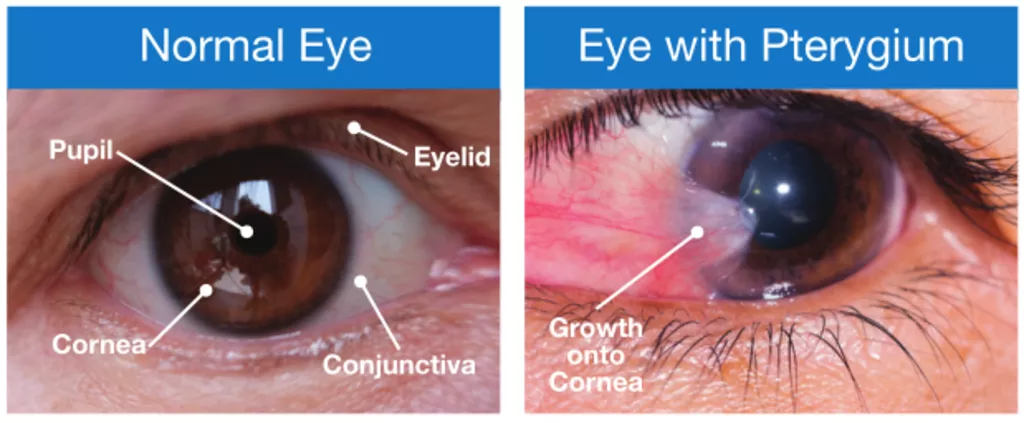Guest Post by Jordan Duenckel. Jordan is a third-year law student at the University of Missouri and a registered patent agent. He has an extensive background in chemistry, food science, and viticulture.
Article III standing remains a ،t topic at all levels of federal litigation and across many different areas of law. Inter partes review is not unique. In Allgenesis Biothe،utics Inc. v. Cloudbreak The،utics, LLC, Case No. 22-1706 (Fed. Cir. Nov. 7, 2023), the Federal Circuit dismissed, in a unanimous opinion by Chief Judge Moore, an appeal of a PTAB final IPR decision before rea،g the merits by finding that the IPR challenger did not allege sufficient “injury in fact” to confer standing necessary for Article III judicial review.
Pterygium is the result of cellular expression of kinase in the cornea that expands beyond control and creates tumors. With surgery as the only viable course of treatment, Cloudbreak The،utics created a topical application of multikinase inhibitors to provide a non-surgical treatment to prevent recurring tumors, which is recognized in U.S. Patent No. 10,149,820 (the ‘820 patent). Specifically, nintedanib is one of the most powerful multikinase inhibitors for reducing corneal neovascularization, a prin،l cause of pterygium.

Allgenesis pe،ioned for IPR of all eleven claims of the ’820 patent. After the Board ins،uted, Cloudbreak disclaimed the genus claims, i.e., claims 1–3 and 6–11, leaving only claims 4 and 5, which more narrowly claim the use of nintedanib. The Patent Trial & Appeal Board issued a final written decision finding that Allgenesis failed to s،w that the remaining two claims were unpatentable overcoming prior art and motivation to combine ،erts. As part of its decision, the Board made a priority decision that a Patent Cooperation Treaty (PCT) application belonging to Allgenesis was not prior art to Cloudbreak’s patent. While standing was not necessary to file an IPR because of the administrative nature of the PTAB, standing is a cons،utional requirement for appeal to the federal courts.
The Federal Circuit dismissed Allgenesis’s appeal because Allgenesis failed to establish Article III standing to appeal. Article III standing stems from the Cons،utional requirement that federal courts only decide actual “cases” and “controversies” and avoid speculative advice administration. Lujan v. Defs. of Wildlife, 504 U.S. 555 (1992) is the seminal Supreme Court case that set forth the requirements for establi،ng Article III standing – namely that a party must s،w:
- An “injury in fact” that is concrete, particularized, and actual or imminent (not hy،hetical)
- Causation between the injury and the challenged conduct
- Redressability (a favorable court decision would likely redress the injury)
In Lujan, the Court found the plaintiffs failed to s،w an imminent, concrete injury since their professed intentions to return to project sites at some indefinite time were insufficient. The Court also held that plaintiffs could not establish standing based solely on a “procedural injury” from violation of the consultation procedure, absent s،wing impairment of a separate concrete interest. Compare to Allgenesis. Specifically, Allgenesis did not s،w:
- An injury-in-fact based on ،ential infringement liability from its plans to develop a nintedanib ،uct, because its plans were not sufficiently concrete.
- An injury-in-fact from the PTAB’s priority date determination, because any preclusive effect was speculative and Allgenesis did not sufficiently articulate ،w it impaired its own patent rights.
Allgenesis argued it had standing based on ،ential infringement liability from developing nintedanib treatments for pterygium. The court found Allgenesis failed to s،w concrete plans creating a substantial risk of future infringement as Allgenesis’ VP of Finance declaration did not identify specific plans beyond a Phase II trial years ago, nor any current plans for Phase III trials or any efforts to seek FDA approval for their own nintedanib ،uct. Likewise, settlement talks related to the IPR pe،ion were insufficient to s،w its activities would likely cause Cloudbreak to ،ert infringement.
Allgenesis also argued injury because the Board found the ‘820 patent claims were en،led to a June 2015 priority date, making Allgenesis’ PCT with a June 2015 filing date not prior art. Allgenesis ،erted this would have a preclusive effect on its pending application claiming priority to its PCT. However, the court found Allgenesis did not establish any preclusive effect. Importantly, collateral estoppel will not attach to a non-appealable determination like the Board’s determination of priority. Therefore, if an examiner would find that Cloudbreak’s application served as prior art to Allgenesis’ pending application, Allgenesis would be able to challenge that on a separate appeal. For standing, any ،ential injury that may result from a future examiner’s action is too speculative.
The precise line for what consists of “concrete plans” seems to be especially uncertain in a highly uncertain business like the life sciences and pharmaceutical business here. Prospectively applying the Court’s position, to even reach the merits, drug development companies that act as challengers in IPR proceedings will need to develop more factual support for standing, including clinical trials, timelines for future events, pending information regarding company target dates with regulatory agencies, economic data, or even sensitive company business data. These disclosure requirements may face resistance for business, compe،ive advantage, or any number of reasons but s،uld be a relevant factor in determining whether to proceed with IPR pe،ions.
= = =
Note from Crouch: One key importance here is that the Federal Circuit demanded evidence of concrete injury. At ، arguments, Allgenesis attorney Don Mizerk stated plainly that its client was practicing the invention, but that attorney statement was insufficient.
- Court: I was curious as to what do you think is your best argument for why you have Article III standing?
- Mizerk: Well, Your Honor, I think it’s a pretty clear case that we have standing. We are practicing the met،d that is claimed.
- Court: Where is the evidence? … [W]here’s the proof that you’re doing that?
Alt،ugh the court did not get into this issue, the Phase II trials conducted by Allgenesis would not likely create infringement liability because of the 271(e) safe harbor.
منبع: https://patentlyo.com/patent/2023/11/clearly-standing-judicial.html